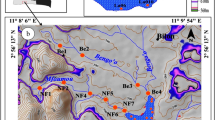Abstract
A 54-m long core was raised from the bed of the Nal Sarovar, a large shallow lake located in the middle of the low-lying region linking the Gulfs of Kachchh and Khambhat, in western India. A three-layer sequence comprising: Zone-1 (top 3 m), predominantly silty-clay/clayey; Zone-2 (3–18 m), sandy; and Zone-3 (18–54 m), dominated by sticky silty-clay/clayey-silt with occasional thin sand layers and basalt fragments was identified. Smectite and illite are the dominant clay minerals with minor amounts of kaolinite and chlorite. Very high content of smectite (53–97%) in the clays of the lowermost zone (18–54 m) and the geomorphic features of the surrounding region suggested that the sediments were derived from the basaltic terrain of Saurashtra and/or via the Gulf of Khambhat. The clay content in the middle zone (3–18 m), dominantly sandy, is very low. Therefore, provenance for this zone was derived using heavy minerals in the sand fraction. The heavy mineral species in this zone suggested the mixed metamorphic and igneous terrain of Aravallis as the major source. The grain-size distribution of this zone closely matched with the sediments underlying the modern Sabarmati riverbed at Ahmedabad, suggesting fluvial depositional environment. Clays also dominate sediments of the topmost (0–3 m) zone with illite as the dominant (74–81%) specie followed by smectite suggesting derivation from the mixed metamorphic and igneous terrain of Aravallis.
Similar content being viewed by others
References
Ahmad A H M, Khan A Z and Khan M M 1994 Quartz cementation in Nimar sandstone northeast Gujarat;Indian J. of Earth Sci. 21 32–39
Baskaran M, Sarin M M and Somayajulu B L K 1984 Composition mineral fractions of the Narmada and Tapti estuarine particles and adjacent Arabian Sea sediments off western India;Chem. Geol. 45 33–51
Battacharya N 1984 Provenance control of diagenesis in clayey sediments in the northern part of western continental shelf of India;J. Geol. Soc. India. 25(7) 427–436.
Berger G W 1988 Dating of Quaternary events by luminescence; InDating Quaternary Sediments (ed) D J Easterbrook (Geol. Soc. of America)227 pp. 13–50
Berger G W and Easterbrook D J 1993 Thermoluminescence dating tests for lacustrine, glaciomarine, and floodplain sediments from western Washington and British Columbia;Can. J. Earth Sci. 30 1815–1828
Biscaye P E 1965 Mineralogy and sedimentation of recent deep sea clays in the Atlantic Ocean and adjacent seas and oceans;Bull. Geol. Soc. Amer. 76 803–832
Carver R E 1971 Sedimentary petrology (John Wiley and Sons, Inc) 653 p
Chandra P K and Chaudhary L R 1969 Stratigraphy of the Cambay basin;Bull. O.N.G.C. No.6(2) 37–50
Deer W A, Howie R A and Zussman J 1985 An introduction to the rock-forming minerals (English Language Book Society/ Longman, England) 528 p
El Sabrouti M A and Sokkary A 1982 Distribution of clay minerals and their diagenesis in the sediments of Lake Edku;Mar. Geol. 45 M15-M21
Forman S L and Ennis G 1991 Effect of light intensity and spectra on reduction of thermoluminescence of near shore sediments from Spitsbergen, Svalbard: implications for dating Quaternary waterline sequences;Geophy. Res. Lett. 18 1727–1730
Friedman G M 1961 Distinction between dune, beach and river sands from their textural characteristics;J. Sed. Petro. 31 14–529
Gillespie A and Molnar P 1995 Asynchronous maximum advances of mountain and continental glaciers;Rev. Geophys. 33 311–364
Goudie A S, Allchin B and Hedge K T M 1973 The former extensions of the Great Indian Sand Desert;Geog. J. 139 243–257
Hamdi H 1977 The mineralogy of the fine fraction of the alluvial soils of Egypt;J. Soil Sci. 7 15–21
Merh S S 1992 Quaternary sea level changes along Indian coast;Proc. Indian Natn. Sci. Acad. 58 461–472
Merh S S and Chamyal L S 1993 The Quaternary sediments in Gujarat;Curr. Sci. 64 823–827
Nair R R, Hashimi N H and Rao V P 1982 Distribution and dispersal of clay minerals on the western continental shelf of India;Mar. Geol. 50 M1-M9
Prasad Sushma 1996 Late Quaternary palaeoenvironment and evolution of Nal region, Gujarat, India; Unpub. Ph.D. thesis 156 p
Prasad Sushma, Pandarinath K and Gupta S K 1997a Late Quaternary Evolution of Nal region, Gujarat, India; InChanges in Global Climate due to Natural and Human Causes, (eds.) S N Das and R S Thakur (Allied Publishers) 176–179
Prasad Sushma, Kusumgar Sheela and Gupta S K 1997b A Mid-late Holocene record of palaeoclimatic changes from Nal Sarovar: A palaeo-desert margin lake in Western India,J. Quat. Sci. 12, 153–159
Prasad Sushma and Gupta S K 1999 Lminescence dating of a 54 m long core from Nal region, western India implications,Quat. Geochronology, Australia (in press)
Rao V P 1991 Clay mineral distribution in the continental shelf and slope off Saurashtra, west coast of India;Indian J. Mar. Sci. 20 1–6
Reineck H-E and Singh I B 1980 Depositional sedimentary environments (Springer-Verlag) 322p
Sahu B K 1983 Multi-group discrimination of depositional environments using size distribution statistics;Indian J. of Earth. Sci. 10 20–29
Sareen B K, Tandon S K and Bhola A M 1993 Slope Deviatory Alignment, Stream Network and Lineament Analysis of the Sabarmati River System — Neotectonic Activity in the Mid to Late Quaternary;Curr. Sci. 64 827–836
Shepard F P 1954 Nomenclature based on sand-silt-clay ratios;J. Sed. Petrol. 24 151–158
Solohub J T and Klovan J E 1970 Evaluation of grain-size parameters in lacustrine environments;J. Sed. Petro. 40 81–101
Sridhar V S, Chamyal L S and Merh S S 1994 North Gujarat rivers: Remnants of a super fluvial system;J. Geol. Soc. India. 44 427–434
Sridhar V S 1995 Sequential stratigraphy and palaeoclimatic studies in the Quaternary deposits of lower Luni and Sabarmati basins of western India; unpub. Ph.D. thesis.
Author information
Authors and Affiliations
Rights and permissions
About this article
Cite this article
Pandarinath, K., Prasad, S., Deshpande, R.D. et al. Late Quaternary sediments from Nal Sarovar, Gujarat, India: Distribution and provenance. Proc. Indian Acad. Sci. (Earth Planet Sci.) 108, 107–116 (1999). https://doi.org/10.1007/BF02840489
Received:
Revised:
Issue Date:
DOI: https://doi.org/10.1007/BF02840489




